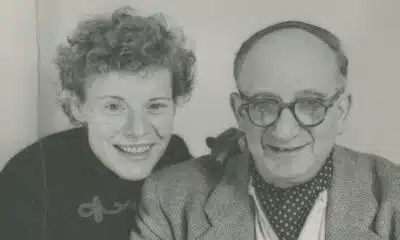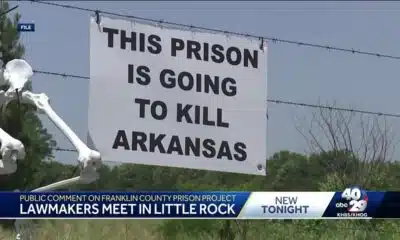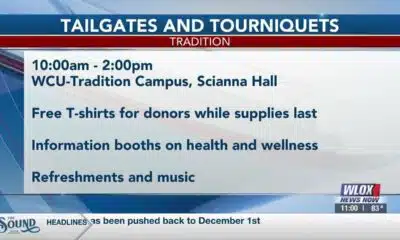Mississippi Today
Prison education programs are primed to take off in Mississippi. Here’s what one class looks like.
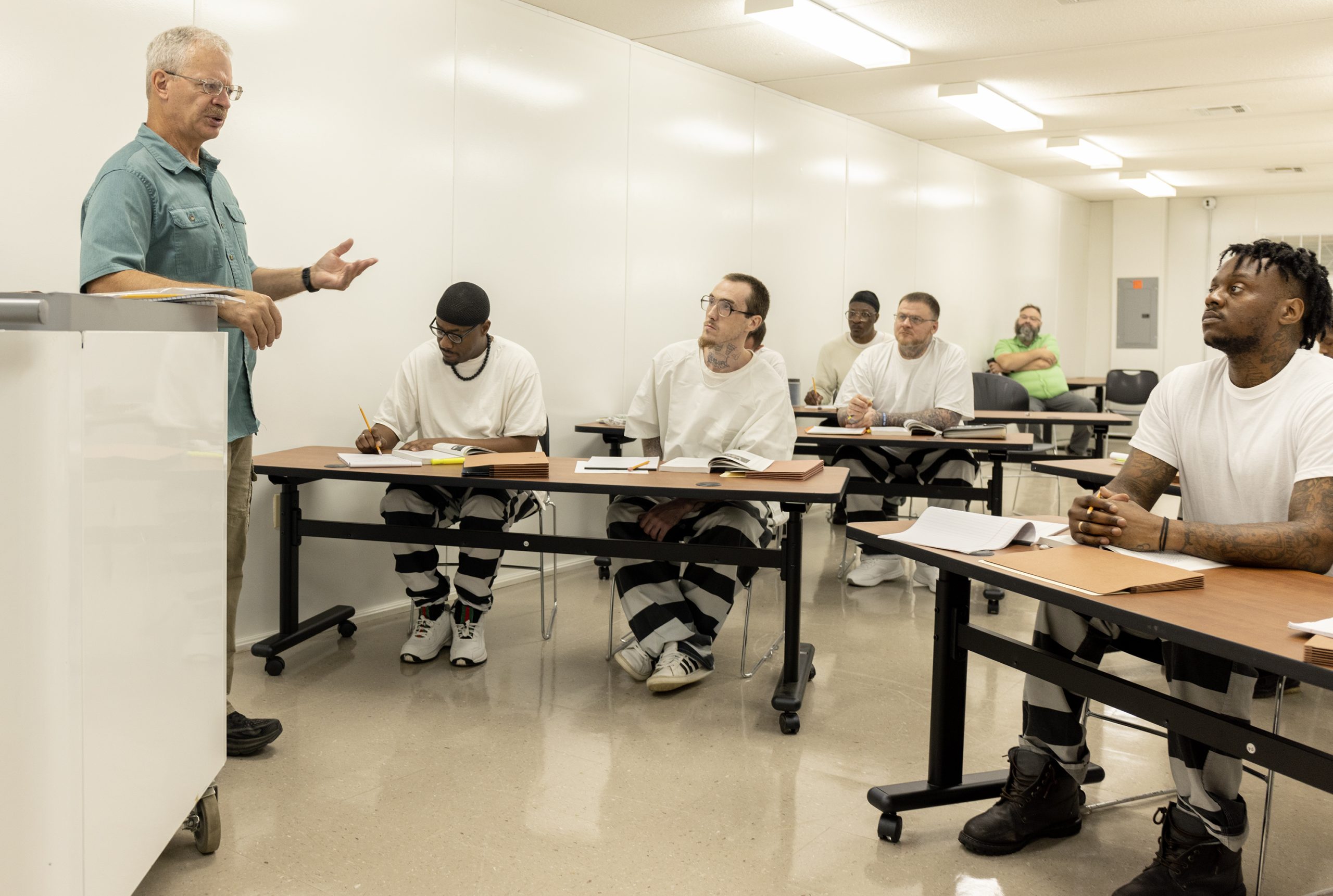
CORINTH — In the back of the Alcorn County Correctional Facility, a regional prison in the top-right corner of Mississippi, is an ice-cold trailer.
It’s new. And it’s where Bill Stone — a retired Northeast Mississippi Community College instructor who, for the past three years, has taught a public speaking class at this prison — was headed early Wednesday afternoon.
To get there, he must go through a pat-down. A guard inspects his materials — folders, notebooks and seven copies of the textbook “Practically Speaking.” Then Stone must walk through the prison’s long, loud hallway, past his old classroom; past the canteen, the case managers’ offices and the guard; and past the living pods. Some of his students come to the glass or they shout hello, adding to the din. Finally, after a few steps on a sidewalk walled-off with a chain-link fence, Stone is inside the trailer.
Sometimes, Stone thinks it’s not unlike walking the halls of a high school.
On Wednesday, he had Michelle Baragona, NEMCC’s vice president of instruction, in tow. She’d driven 20 minutes from NEMCC’s main campus in Booneville. Since fall 2017, she has overseen NEMCC’s prison education programs, which are part of a growing movement in Mississippi and across the country. Boosted in part by research that has shown that prison education reduces recidivism, more colleges and universities are offering classes in prison.
Now, as the federal government is preparing to make federal financial aid once again available to incarcerated people starting July 1, these programs are primed to explode in partnership with the Mississippi Department of Corrections. Key stakeholders are on board: In interviews, Burl Cain, the MDOC commissioner, has correctly linked the availability of jobs for formerly incarcerated people, which prison education can help them get, to reduced recidivism.
In the quiet, air-conditioned trailer, Stone was hoping his students could, just for an hour, find some reprieve from prison. Or at least, from their often sweltering hot living pods, which on Wednesday were burning up in the 84-degree heat. All 295 students at this facility can take classes, as long as they have a GED.
“This is much better than the old room,” Stone said. “By a long, long shot.”
He started arranging the desks into three rows.
Around 12:20 p.m., guards brought the students from each living zone until all the desks were filled. They waited quietly for class to start. Some were antsy, tapping their feet or twirling their pencils. One student from the work zone was running behind.
Five minutes later, class started. Stone introduced the assignment. Each student was to talk about three things that interested them. If they talked for more than one minute, they’d get an A.
“At the end, we all clap for them,” he told the class. “Even if they pass out.”
Stone was confident they wouldn’t, but in his 28 years of teaching public speaking, it had happened to two students — it’s always a possibility. So he’d tapped one student to start them off.
“Terrence, I asked you to go first,” Stone said. “Are you ready?”
“Ready as I’m gonna be,” he replied.
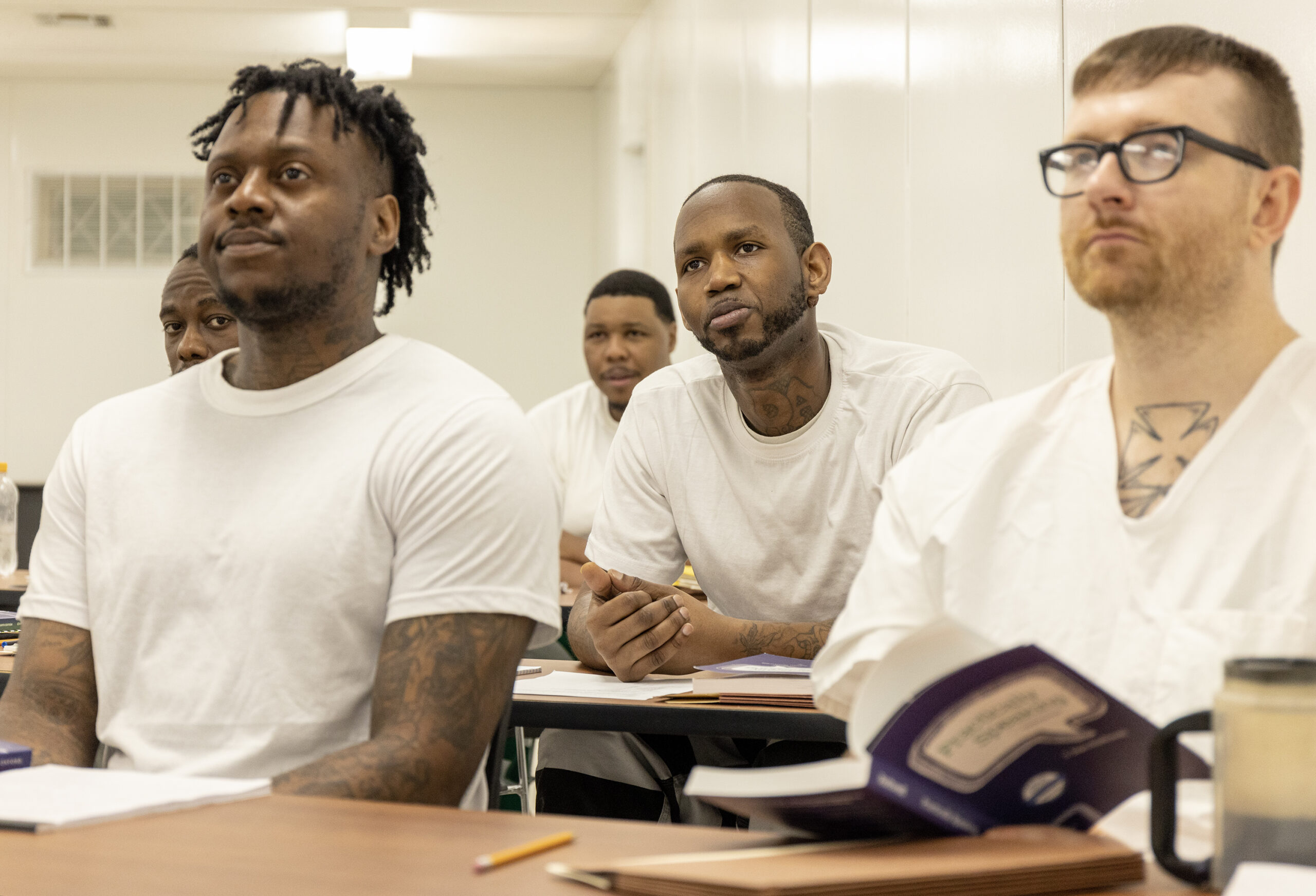
There used to be hundreds of college classes just like Stone’s in prisons across the country. Up until the mid-1990s, these programs were considered a key part of doing time — an “opportunity for ‘reformation,’” according to Higher Education in Prison Research. But in 1994, the Crime Bill took away the primary source of funding, which was the Pell Grant, a federal financial aid program for low-income students, by barring incarcerated people from receiving it.
The classes all but disappeared. Now, they’re making a comeback. In Mississippi, colleges and universities across the state are working with MDOC, sheriffs and wardens to set up what are, for many prisons, the first accredited college classes that have been offered in decades. NEMCC had been supporting its programs with private funding, but the Pell Grant will be a game-changer.
This will benefit the whole community, Baragona said. Not only does prison education reduce crime, she said, but families of incarcerated people often move to Alcorn County. They want their loved ones to be able to support the family when they get out.
“We’re not teaching the people who are in there for life,” Baragona said. “These are people who are fixin’ to rejoin society.”
Since 2017, 77 students have taken NEMCC classes at Alcorn County Correctional. The participation rates reflect the institutions’ demographics, Baragona said. Black students made up 57% of participants, and 43% were white — a ratio that was mirrored in Stone’s class, where 7 students were Black and 4 were white.
More than half have taken three or more classes. Two students have taken five classes.
“I don’t want anybody thinking that this is a patsy,” Stone said. “I want these students to write as well, to speak as well as any Northeast student who has come through my traditional classes.”
He poised his finger over the iPad timer as Terrence Glover stepped up to the podium.
“Hello Terrence,” the students said in unison.
Glover talked about how he hates foreign languages (difficult to learn) and loves fishing. Then, 138 seconds later, his speech was over. It was time for the next student. Stone asked for a volunteer. No one moved.
“Anybody that just wants to get it over with right now?” Stone asked.
Carlos White rocked out of his chair. Though he had seemed shy at his desk, he was at ease at the podium. The first thing he was interested in, White said, was TikTok, because it offered access to “a multitude of people from a single device” — that is, to the outside world. He also liked cooking, because it reminded him of his grandmother’s collard greens. His final interest was mentoring. That’s what he wants to do when he gets out.
“So much of the youth go down the wrong road like I did,” he said.
White spoke for 139 seconds, Stone noted. A new record.
The students seemed less anxious and more comfortable sharing. For many, the topic of prison was unavoidable. Another, Vincent Breazeale, talked about the value of education, working and family — three interests, he said, that would “probably be different outside these walls.”
What everyone was really talking about were their dreams, and what they hoped to do when they finally left. One said he’d like to get a dog. Another couldn’t wait to work on cars again. A third student said wanted to start a business manufacturing cologne.
One of the last students to go, Antonio Harris, said that after 19 years of incarceration, he was looking forward to being an entrepreneur when he’s finally released (he’ll become eligible next year).
“I want to be able to work and still kind of like, enjoy life at the same time,” Harris said. “It generates great revenue also.”
By the end, the temperature in the class felt warmer. Stone congratulated the students. This was the first class he’s ever had, he said, where every student talked for more than a minute. He wanted to know how it felt.
“Like riding a bike,” Glover said.
A student named Bruce Parker passed out root-beer-float-flavored candies. He’d used $1.16 of his $20-a-week allowance to pay for a bag.
After a lecture from Stone, it was time for the students to talk to the “navigator.” That is Tina Wilburn. It’s her third day. She’s NEMCC’s eyes and ears in the prison, and it’s her job to advocate for the students. Gripping a prison-issued walkie talkie and a notebook, she wanted to know how they were going to do their homework.
“Are you able to study in the pod where you’re at?” she asked. She’d heard the library was too small.
All the students shook their heads. Dozens of incarcerated people live in each pod and sleep bunk-to-bunk. There’s a lot of distractions.

“It’s extremely difficult,” White said.
Despite everyone’s excitement that day, these students are up against tough odds. They’re unlikely to finish. Last semester, 10 students enrolled, and only two graduated. According to data from NEMCC, the completion rates were higher before COVID, when more career-readiness classes were offered.
Some of the reasons for this have to do with the very nature of prisons, said Ruth Delaney, a program director at the Vera Institute of Justice, a national organization that has been helping prisons set up college classes. For instance, it’s common for incarcerated people to be suddenly transferred for reasons that supersede the class, like a sentencing order that prohibits them from staying in the same prison as a co-defendant.
“A prison is a total institution,” Delaney said. “The minute you cross that threshold, all of your relationships start to feel different.”
If a fight broke out in a students’ living pod, they could be transferred, even if they weren’t participating, she added. That’s more likely to happen during the summer months, when violence in prison rises with the temperature outside. And while some research has shown prisons that have classes become safer over time, the students at Alcorn County Correctional said they had yet to see that happen.
But other reasons can be managed. A huge issue Stone has noticed is dental hygiene. When his incarcerated students’ have cavities, they’re sent to the Mississippi State Prison in Parchman to get teeth pulled. For weeks after, their mouths are too swollen for them to talk in class.
Then there are some students who get demoralized if they do poorly, even on a quiz that doesn’t matter for their final grade.
“It’ll just knock them for a loop, and I’m not used to that,” Stone said. “That’s a definite prison-type thing. A regular college student would go, ‘well, crap.’ They’d just keep on going. For a prison student to make a 40 or a 50, their whole self esteem is locked up in that.”
What makes the difference, Stone added, is support.
All of the students told Wilburn they would be able to finish their homework. Some of them offered tips: The best time to study is around 3 a.m. That’s when the prison is quietest.
The door to the trailer opened. It was a guard. He walked into the middle of the room with his hands on his hips. Everybody turned to look at him.
“I believe they said class is over now,” he said.
So it was.

NEMCC has big dreams for the program. Baragona wants to offer more career-technical programs — classes that are more likely to directly lead to jobs when students are no longer incarcerated. But she’s worried about the logistics of bringing equipment into the prison.
Another issue is giving students computers, which is crucial for learning how to do research. This isn’t possible because they’re not allowed free use of the internet. Stone makes up for that by bringing print-outs of research to class.
Baragona also wants there to be more instructors. Right now, Stone is one of two. Even though society is slowly leaving the tough-on-crime era behind, she still has to “sweet talk” instructors into participating in the program. She was able to convince Stone because, in the early 1980s, he used to minister to a congregant in prison.
And Baragona still hasn’t figured out an efficient way of providing accommodations for students who have disabilities like dyslexia. When the Pell Grant becomes available, she’ll need to set up a system for them to talk to NEMCC’s financial aid office. She’s hoping Wilburn can help with that.
Before class, Baragona asked Stone to tell her if he needed more equipment. A white board would be nice, he mused. Then he thought of something even better.
“A bigger TV would be glorious,” he said. “If someone had an extra 69-inch TV that would be just glorious.”
But right now, the new trailer is enough.
This article first appeared on Mississippi Today and is republished here under a Creative Commons license.
Mississippi Today
Mississippi prepares for another execution
The Mississippi Supreme Court has set the execution of a man who kidnapped and murdered a 20-year-old community college student in north Mississippi 30 years ago.
Charles Ray Crawford, 59, is set to be executed Oct. 15 at the Mississippi State Penitentiary at Parchman, after multiple requests by the attorney general’s office.
Eight justices joined the majority opinion to set the execution, concluding that Crawford has exhausted all state and federal legal remedies. Mississippi Supreme Court Justice T. Kenneth Griffis Jr. wrote the Friday opinion. Justice David Sullivan did not participate.
However, Kristy Noble with the Mississippi Office of Capital Post-Conviction Counsel released a statement saying it will file another appeal with the U.S. Supreme Court.
“”Mr. Crawford’s inexperienced trial counsel conceded his guilt to the jury — against Mr.
Crawford’s timely and repeated objections,” Noble said in the statement. “Mr. Crawford told his counsel to pursue a not guilty verdict. Counsel did just the opposite, which is precisely what the U.S. Supreme Court says counsel cannot do,” Noble said in the statement.
“A trial like Mr. Crawford’s – one where counsel concedes guilt over his client’s express wishes – is essentially no trial at all.”
Last fall, Crawford’s attorneys asked the court not to set an execution date because he hadn’t exhausted appeal efforts in federal court to challenge a rape conviction that is not tied to his death sentence. In June, the U.S. Supreme Court declined to take up Crawford’s case.
A similar delay occurred a decade ago, when the AG’s office asked the court to reset Crawford’s execution date, but that was denied because efforts to appeal his unrelated rape conviction were still pending.
After each unsuccessful filing, the attorney general’s office asked the Mississippi Supreme Court to set Crawford’s execution date.
On Friday, the court also denied Crawford’s third petition for post-conviction relief and a request for oral argument. It accepted the state’s motion to dismiss the petition. Seven justices concurred and Justice Leslie King concurred in result only. Again, Justice Sullivan did not participate.
Crawford was convicted and sentenced to death in Lafayette County for the 1993 rape and murder of North Mississippi Community College student Kristy Ray.
Days before he was set to go to trial on separate aggravated assault and rape charges, he kidnapped Ray from her parents’ Tippah County home, leaving ransom notes. Crawford took Ray to an abandoned barn where he stabbed her, and his DNA was found on her, indicating he sexually assaulted her, according to court records.
Crawford told police he had blackouts and only remembered parts of the crime, but not killing Ray. Later he admitted “he must of killed her” and led police to Ray’s body, according to court records.
At his 1994 trial he presented an insanity defense, including that he suffered from psychogenic amnesia – periods of time lapse without memory. Medical experts who provided rebuttal testimony said Crawford didn’t have psychogenic amnesia and didn’t show evidence of bipolar illness.
The last person executed in Mississippi was Richard Jordan in June, previously the state’s oldest and longest serving person on death row.
There are 36 people on death row, according to records from the Mississippi Department of Corrections.
Update 9/15/25: This story has been updated to include a response from the Mississippi Office of Capital Post-Conviction Counsel
This article first appeared on Mississippi Today and is republished here under a Creative Commons Attribution-NoDerivatives 4.0 International License.
The post Mississippi prepares for another execution appeared first on mississippitoday.org
Note: The following A.I. based commentary is not part of the original article, reproduced above, but is offered in the hopes that it will promote greater media literacy and critical thinking, by making any potential bias more visible to the reader –Staff Editor.
Political Bias Rating: Centrist
The article presents a factual and balanced account of the legal proceedings surrounding a scheduled execution in Mississippi. It includes perspectives from both the state’s attorney general’s office and the defense counsel, without using emotionally charged language or advocating for a particular political stance. The focus on legal details and court decisions reflects a neutral, informative approach typical of centrist reporting.
Mississippi Today
Presidents are taking longer to declare major natural disasters. For some, the wait is agonizing
TYLERTOWN — As an ominous storm approached Buddy Anthony’s one-story brick home, he took shelter in his new Ford F-250 pickup parked under a nearby carport.
Seconds later, a tornado tore apart Anthony’s home and damaged the truck while lifting it partly in the air. Anthony emerged unhurt. But he had to replace his vehicle with a used truck that became his home while waiting for President Donald Trump to issue a major disaster declaration so that federal money would be freed for individuals reeling from loss. That took weeks.
“You wake up in the truck and look out the windshield and see nothing. That’s hard. That’s hard to swallow,” Anthony said.
Disaster survivors are having to wait longer to get aid from the federal government, according to a new Associated Press analysis of decades of data. On average, it took less than two weeks for a governor’s request for a presidential disaster declaration to be granted in the 1990s and early 2000s. That rose to about three weeks during the past decade under presidents from both major parties. It’s taking more than a month, on average, during Trump’s current term, the AP found.
The delays mean individuals must wait to receive federal aid for daily living expenses, temporary lodging and home repairs. Delays in disaster declarations also can hamper recovery efforts by local officials uncertain whether they will receive federal reimbursement for cleaning up debris and rebuilding infrastructure. The AP collaborated with Mississippi Today and Mississippi Free Press on the effects of these delays for this report.
“The message that I get in the delay, particularly for the individual assistance, is that the federal government has turned its back on its own people,” said Bob Griffin, dean of the College of Emergency Preparedness, Homeland Security and Cybersecurity at the University at Albany in New York. “It’s a fundamental shift in the position of this country.”
The wait for disaster aid has grown as Trump remakes government
The Federal Emergency Management Agency often consults immediately with communities to coordinate their initial disaster response. But direct payments to individuals, nonprofits and local governments must wait for a major disaster declaration from the president, who first must receive a request from a state, territory or tribe. Major disaster declarations are intended only for the most damaging events that are beyond the resources of states and local governments.
Trump has approved more than two dozen major disaster declarations since taking office in January, with an average wait of almost 34 days after a request. That ranged from a one-day turnaround after July’s deadly flash flooding in Texas to a 67-day wait after a request for aid because of a Michigan ice storm. The average wait is up from a 24-day delay during his first term and is nearly four times as long as the average for former Republican President George H.W. Bush, whose term from 1989-1993 coincided with the implementation of a new federal law setting parameters for disaster determinations.
The delays have grown over time, regardless of the party in power. Former Democratic President Joe Biden, in his last year in office, averaged 26 days to declare major disasters — longer than any year under former Democratic President Barack Obama.
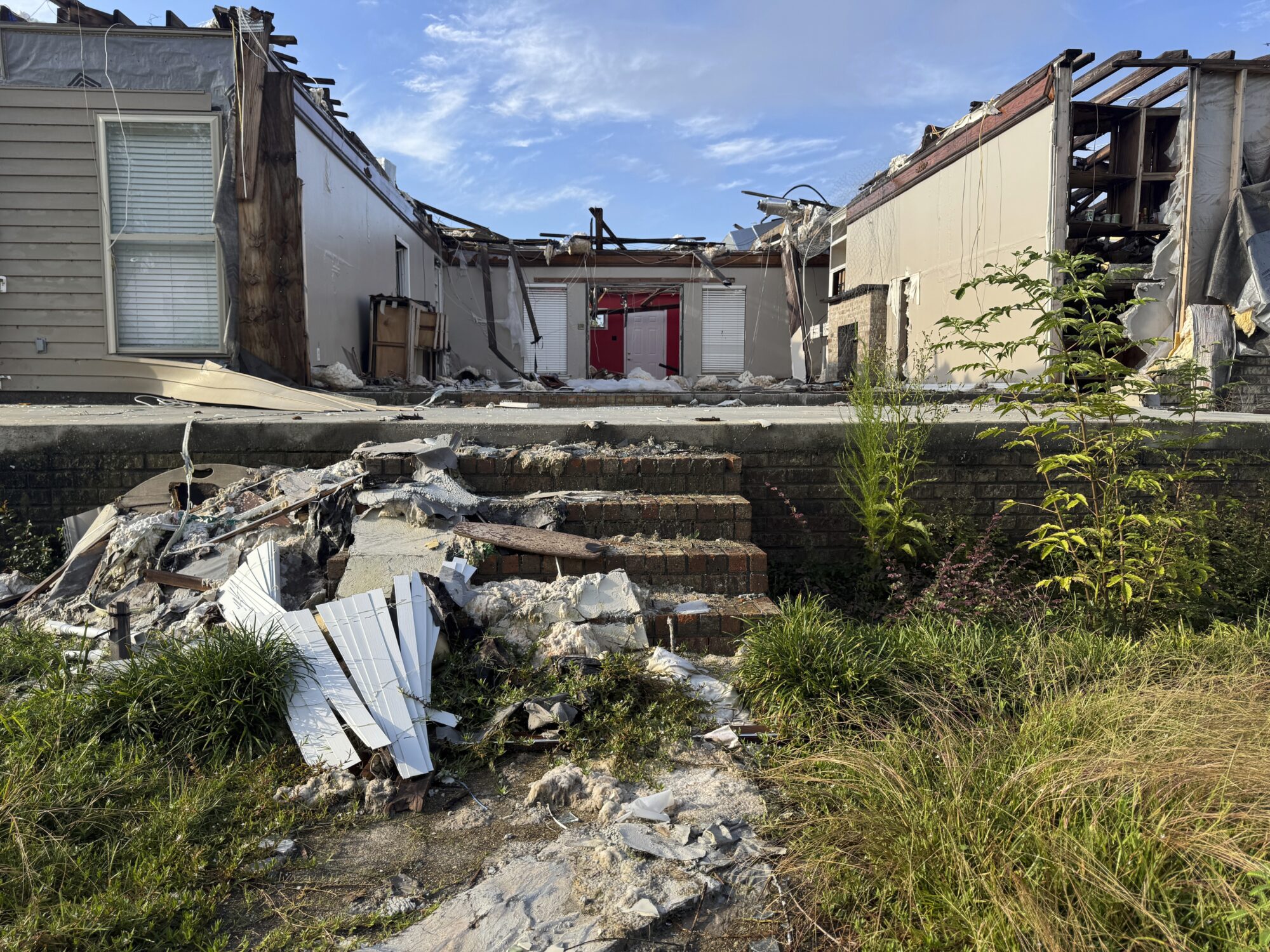
FEMA did not respond to the AP’s questions about what factors are contributing to the trend.
Others familiar with FEMA noted that its process for assessing and documenting natural disasters has become more complex over time. Disasters have also become more frequent and intense because of climate change, which is mostly caused by the burning of fuels such as gas, coal and oil.
The wait for disaster declarations has spiked as Trump’s administration undertakes an ambitious makeover of the federal government that has shed thousands of workers and reexamined the role of FEMA. A recently published letter from current and former FEMA employees warned the cuts could become debilitating if faced with a large-enough disaster. The letter also lamented that the Trump administration has stopped maintaining or removed long-term planning tools focused on extreme weather and disasters.
Shortly after taking office, Trump floated the idea of “getting rid” of FEMA, asserting: “It’s very bureaucratic, and it’s very slow.”
FEMA’s acting chief suggested more recently that states should shoulder more responsibility for disaster recovery, though FEMA thus far has continued to cover three-fourths of the costs of public assistance to local governments, as required under federal law. FEMA pays the full cost of its individual assistance.
Former FEMA Administrator Pete Gaynor, who served during Trump’s first term, said the delay in issuing major disaster declarations likely is related to a renewed focus on making sure the federal government isn’t paying for things state and local governments could handle.
“I think they’re probably giving those requests more scrutiny,” Gaynor said. “And I think it’s probably the right thing to do, because I think the (disaster) declaration process has become the ‘easy button’ for states.”
The Associated Press on Monday received a statement from White House spokeswoman Abigail Jackson in response to a question about why it is taking longer to issue major natural disaster declarations:
“President Trump provides a more thorough review of disaster declaration requests than any Administration has before him. Gone are the days of rubber stamping FEMA recommendations – that’s not a bug, that’s a feature. Under prior Administrations, FEMA’s outsized role created a bloated bureaucracy that disincentivized state investment in their own resilience. President Trump is committed to right-sizing the Federal government while empowering state and local governments by enabling them to better understand, plan for, and ultimately address the needs of their citizens. The Trump Administration has expeditiously provided assistance to disasters while ensuring taxpayer dollars are spent wisely to supplement state actions, not replace them.”

In Mississippi, frustration festered during wait for aid
The tornado that struck Anthony’s home in rural Tylertown on March 15 packed winds up to 140 mph. It was part of a powerful system that wrecked homes, businesses and lives across multiple states.
Mississippi’s governor requested a federal disaster declaration on April 1. Trump granted that request 50 days later, on May 21, while approving aid for both individuals and public entities.
On that same day, Trump also approved eight other major disaster declarations for storms, floods or fires in seven other states. In most cases, more than a month had passed since the request and about two months since the date of those disasters.
If a presidential declaration and federal money had come sooner, Anthony said he wouldn’t have needed to spend weeks sleeping in a truck before he could afford to rent the trailer where he is now living. His house was uninsured, Anthony said, and FEMA eventually gave him $30,000.
In nearby Jayess in Lawrence County, Dana Grimes had insurance but not enough to cover the full value of her damaged home. After the eventual federal declaration, Grimes said FEMA provided about $750 for emergency expenses, but she is now waiting for the agency to determine whether she can receive more.

“We couldn’t figure out why the president took so long to help people in this country,” Grimes said. “I just want to tie up strings and move on. But FEMA — I’m still fooling with FEMA.”
Jonathan Young said he gave up on applying for FEMA aid after the Tylertown tornado killed his 7-year-old son and destroyed their home. The process seemed too difficult, and federal officials wanted paperwork he didn’t have, Young said. He made ends meet by working for those cleaning up from the storm.
“It’s a therapy for me,” Young said, “to pick up the debris that took my son away from me.”
Historically, presidential disaster declarations containing individual assistance have been approved more quickly than those providing assistance only to public entities, according to the AP’s analysis. That remains the case under Trump, though declarations for both types are taking longer.
About half the major disaster declarations approved by Trump this year have included individual assistance.
Some people whose homes are damaged turn to shelters hosted by churches or local nonprofit organizations in the initial chaotic days after a disaster. Others stay with friends or family or go to a hotel, if they can afford it.
But some insist on staying in damaged homes, even if they are unsafe, said Chris Smith, who administered FEMA’s individual assistance division under three presidents from 2015-2022. If homes aren’t repaired properly, mold can grow, compounding the recovery challenges.
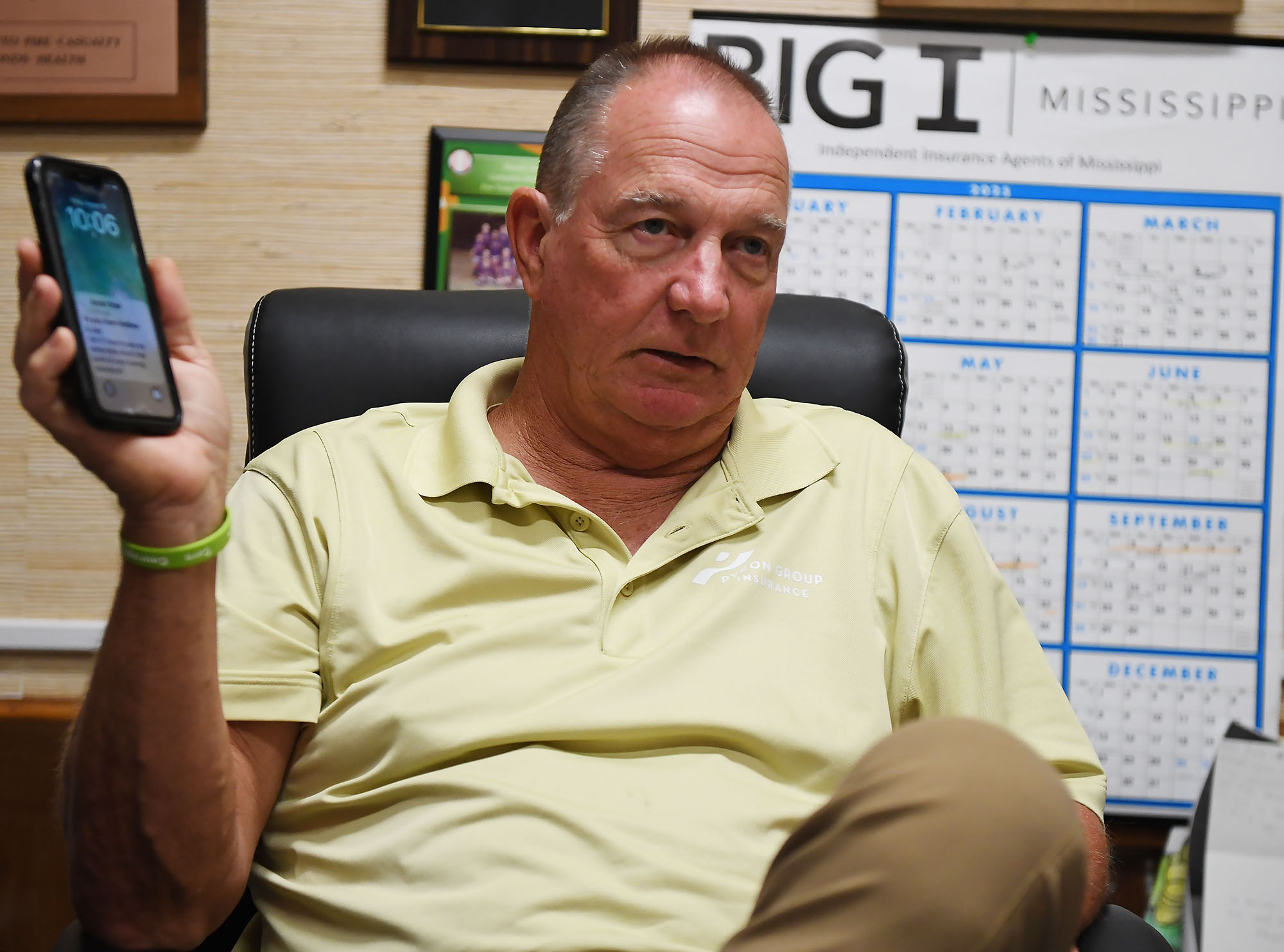
That’s why it’s critical for FEMA’s individual assistance to get approved quickly — ideally, within two weeks of a disaster, said Smith, who’s now a disaster consultant for governments and companies.
“You want to keep the people where they are living. You want to ensure those communities are going to continue to be viable and recover,” Smith said. “And the earlier that individual assistance can be delivered … the earlier recovery can start.”
In the periods waiting for declarations, the pressure falls on local officials and volunteers to care for victims and distribute supplies.
In Walthall County, where Tylertown is, insurance agent Les Lampton remembered watching the weather news as the first tornado missed his house by just an eighth of a mile. Lampton, who moonlights as a volunteer firefighter, navigated the collapsed trees in his yard and jumped into action. About 45 minutes later, the second tornado hit just a mile away.
“It was just chaos from there on out,” Lampton said.
Walthall County, with a population of about 14,000, hasn’t had a working tornado siren in about 30 years, Lampton said. He added there isn’t a public safe room in the area, although a lot of residents have ones in their home.
Rural areas with limited resources are hit hard by delays in receiving funds through FEMA’s public assistance program, which, unlike individual assistance, only reimburses local entities after their bills are paid. Long waits can stoke uncertainty and lead cost-conscious local officials to pause or scale-back their recovery efforts.
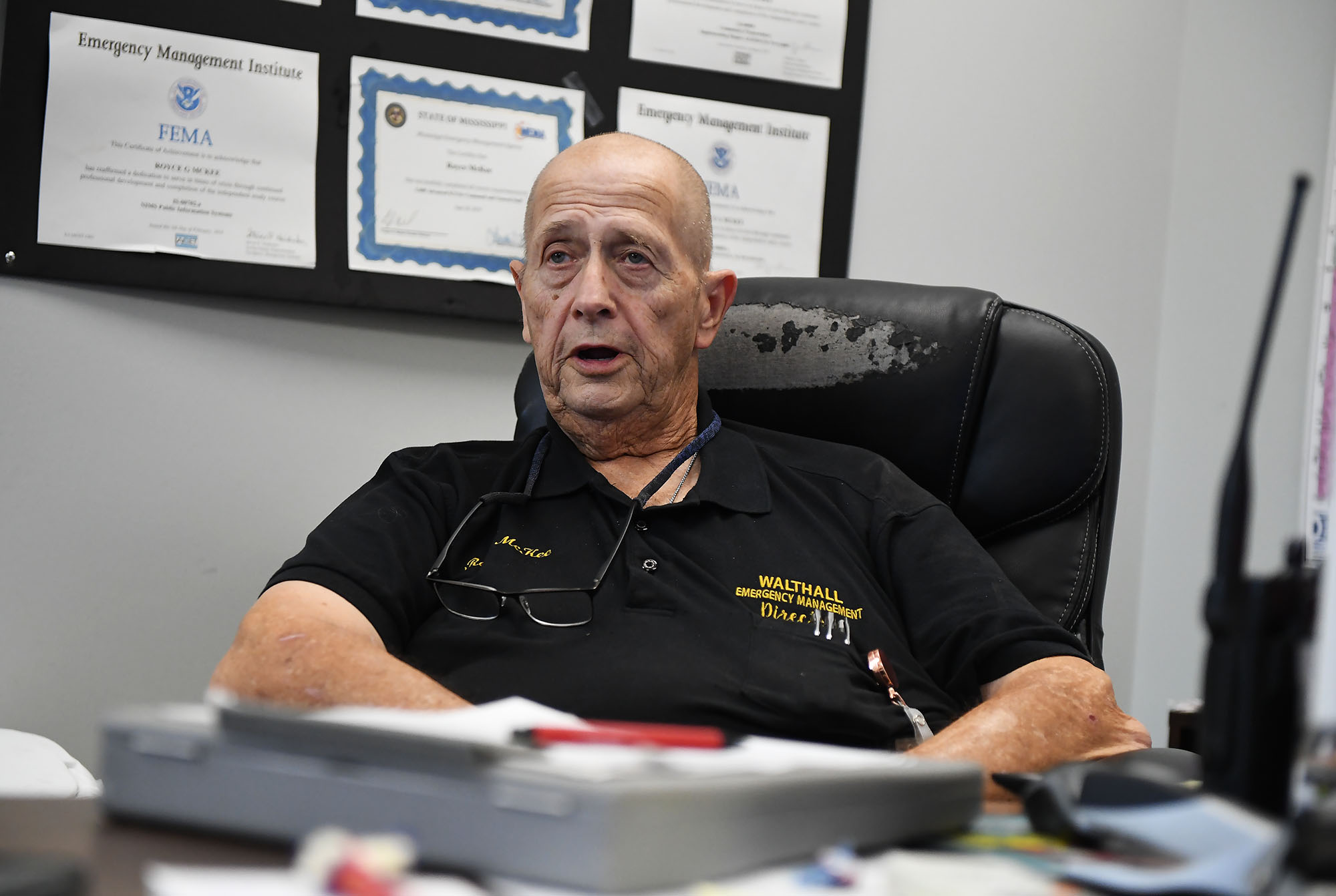
In Walthall County, officials initially spent about $700,000 cleaning up debris, then suspended the cleanup for more than a month because they couldn’t afford to spend more without assurance they would receive federal reimbursement, said county emergency manager Royce McKee. Meanwhile, rubble from splintered trees and shattered homes remained piled along the roadside, creating unsafe obstacles for motorists and habitat for snakes and rodents.
When it received the federal declaration, Walthall County took out a multimillion-dollar loan to pay contractors to resume the cleanup.
“We’re going to pay interest and pay that money back until FEMA pays us,” said Byran Martin, an elected county supervisor. “We’re hopeful that we’ll get some money by the first of the year, but people are telling us that it could be [longer].”
Lampton, who took after his father when he joined the volunteer firefighters 40 years ago, lauded the support of outside groups such as Cajun Navy, Eight Days of Hope, Samaritan’s Purse and others. That’s not to mention the neighbors who brought their own skid steers and power saws to help clear trees and other debris, he added.
“That’s the only thing that got us through this storm, neighbors helping neighbors,” Lampton said. “If we waited on the government, we were going to be in bad shape.”
Lieb reported from Jefferson City, Missouri, and Wildeman from Hartford, Connecticut.
Update 98/25: This story has been updated to include a White House statement released after publication.
This article first appeared on Mississippi Today and is republished here under a Creative Commons Attribution-NoDerivatives 4.0 International License.
The post Presidents are taking longer to declare major natural disasters. For some, the wait is agonizing appeared first on mississippitoday.org
Note: The following A.I. based commentary is not part of the original article, reproduced above, but is offered in the hopes that it will promote greater media literacy and critical thinking, by making any potential bias more visible to the reader –Staff Editor.
Political Bias Rating: Center-Left
This article presents a critical view of the Trump administration’s handling of disaster declarations, highlighting delays and their negative impacts on affected individuals and communities. It emphasizes concerns about government downsizing and reduced federal support, themes often associated with center-left perspectives that favor robust government intervention and social safety nets. However, it also includes statements from Trump administration officials defending their approach, providing some balance. Overall, the tone and framing lean slightly left of center without being overtly partisan.
Mississippi Today
Northeast Mississippi speaker and worm farmer played key role in Coast recovery after Hurricane Katrina
The 20th anniversary of Hurricane Katrina slamming the Mississippi Gulf Coast has come and gone, rightfully garnering considerable media attention.
But still undercovered in the 20th anniversary saga of the storm that made landfall on Aug. 29, 2005, and caused unprecedented destruction is the role that a worm farmer from northeast Mississippi played in helping to revitalize the Coast.
House Speaker Billy McCoy, who died in 2019, was a worm farmer from the Prentiss, not Alcorn County, side of Rienzi — about as far away from the Gulf Coast as one could be in Mississippi.
McCoy grew other crops, but a staple of his operations was worm farming.
Early after the storm, the House speaker made a point of touring the Coast and visiting as many of the House members who lived on the Coast as he could to check on them.
But it was his action in the forum he loved the most — the Mississippi House — that is credited with being key to the Coast’s recovery.
Gov. Haley Barbour had called a special session about a month after the storm to take up multiple issues related to Katrina and the Gulf Coast’s survival and revitalization. The issue that received the most attention was Barbour’s proposal to remove the requirement that the casinos on the Coast be floating in the Mississippi Sound.
Katrina wreaked havoc on the floating casinos, and many operators said they would not rebuild if their casinos had to be in the Gulf waters. That was a crucial issue since the casinos were a major economic engine on the Coast, employing an estimated 30,000 in direct and indirect jobs.
It is difficult to fathom now the controversy surrounding Barbour’s proposal to allow the casinos to locate on land next to the water. Mississippi’s casino industry that was birthed with the early 1990s legislation was still new and controversial.
Various religious groups and others had continued to fight and oppose the casino industry and had made opposition to the expansion of gambling a priority.
Opposition to casinos and expansion of casinos was believed to be especially strong in rural areas, like those found in McCoy’s beloved northeast Mississippi. It was many of those rural areas that were the homes to rural white Democrats — now all but extinct in the Legislature but at the time still a force in the House.
So, voting in favor of casino expansion had the potential of being costly for what was McCoy’s base of power: the rural white Democrats.
Couple that with the fact that the Democratic-controlled House had been at odds with the Republican Barbour on multiple issues ranging from education funding to health care since Barbour was inaugurated in January 2004.
Barbour set records for the number of special sessions called by the governor. Those special sessions often were called to try to force the Democratic-controlled House to pass legislation it killed during the regular session.
The September 2005 special session was Barbour’s fifth of the year. For context, current Gov. Tate Reeves has called four in his nearly six years as governor.
There was little reason to expect McCoy to do Barbour’s bidding and lead the effort in the Legislature to pass his most controversial proposal: expanding casino gambling.
But when Barbour ally Lt. Gov. Amy Tuck, who presided over the Senate, refused to take up the controversial bill, Barbour was forced to turn to McCoy.
The former governor wrote about the circumstances in an essay he penned on the 20th anniversary of Hurricane Katrina for Mississippi Today Ideas.
“The Senate leadership, all Republicans, did not want to go first in passing the onshore casino law,” Barbour wrote. “So, I had to ask Speaker McCoy to allow it to come to the House floor and pass. He realized he should put the Coast and the state’s interests first. He did so, and the bill passed 61-53, with McCoy voting no.
“I will always admire Speaker McCoy, often my nemesis, for his integrity in putting the state first.”
Incidentally, former Rep. Bill Miles of Fulton, also in northeast Mississippi, was tasked by McCoy with counting, not whipping votes, to see if there was enough support in the House to pass the proposal. Not soon before the key vote, Miles said years later, he went to McCoy and told him there were more than enough votes to pass the legislation so he was voting no and broached the idea of the speaker also voting no.
It is likely that McCoy would have voted for the bill if his vote was needed.
Despite his no vote, the Biloxi Sun Herald newspaper ran a large photo of McCoy and hailed the Rienzi worm farmer as a hero for the Mississippi Gulf Coast.
This article first appeared on Mississippi Today and is republished here under a Creative Commons Attribution-NoDerivatives 4.0 International License.
The post Northeast Mississippi speaker and worm farmer played key role in Coast recovery after Hurricane Katrina appeared first on mississippitoday.org
Note: The following A.I. based commentary is not part of the original article, reproduced above, but is offered in the hopes that it will promote greater media literacy and critical thinking, by making any potential bias more visible to the reader –Staff Editor.
Political Bias Rating: Centrist
The article presents a factual and balanced account of the political dynamics surrounding Hurricane Katrina recovery efforts in Mississippi, focusing on bipartisan cooperation between Democratic and Republican leaders. It highlights the complexities of legislative decisions without overtly favoring one party or ideology, reflecting a neutral and informative tone typical of centrist reporting.
-
News from the South - Arkansas News Feed7 days ago
Group in lawsuit say Franklin county prison land was bought before it was inspected
-
News from the South - Kentucky News Feed6 days ago
Lexington man accused of carjacking, firing gun during police chase faces federal firearm charge
-
The Center Square6 days ago
California mother says daughter killed herself after being transitioned by school | California
-
News from the South - Arkansas News Feed6 days ago
Arkansas medical marijuana sales on pace for record year
-
Local News Video6 days ago
William Carey University holds 'tailgates and tourniquets' blood drive
-
News from the South - Alabama News Feed6 days ago
Zaxby's Player of the Week: Dylan Jackson, Vigor WR
-
News from the South - Missouri News Feed6 days ago
Local, statewide officials react to Charlie Kirk death after shooting in Utah
-
Local News6 days ago
US stocks inch to more records as inflation slows and Oracle soars












